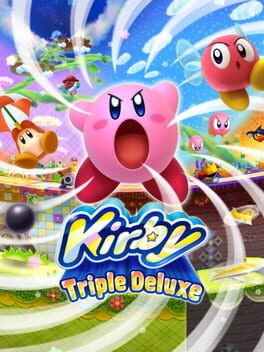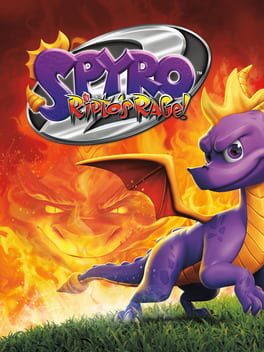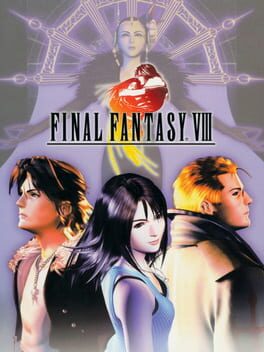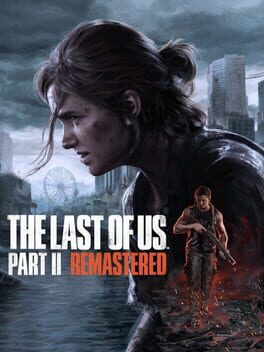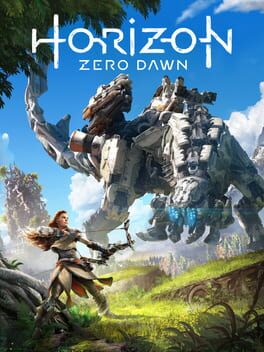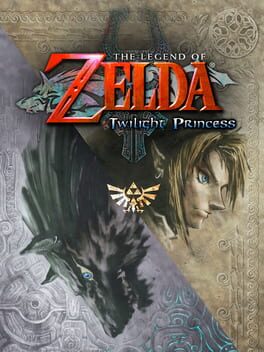spicedapples
29 Reviews liked by spicedapples
Kirby Triple Deluxe
2014
I had a more detailed review ready for this game but by the end of it, I really had nothing to say or wanted to say anything about it. I was completely exhausted by the end of this short game, which is a miracle of its own. It wasn't grueling just boring and repetitive, the second half was just using the first part of the game as its levels. Music was good, not memorable and the visuals other than the CG scenes were good. Maybe there's a better Kirby game out there, but this isn't a good first impression.
I have never played a Silent Hill game before this one, so this is my introduction into the series. I saw all the backlash this was getting on here and figured, it's short and free, why not join in. I didn't despise it like some people did (though I also can't reference any other SH games) but I definitely didn't think it was good overall. Tho there were a couple things I liked.
While I didn't think the story was executed well, I can kinda see what they were going for with the themes. I feel like a lot of people, younger people especially so, can relate to some of them which is nice. I also thought the ending was kinda nice, mostly when those ending messages popped up cuz sometimes you really do need someone to talk to about this stuff. Also the live action segments were neat.
The rest of the game however, sadly sucked. The story overall is just not given enough time for you to really care about these characters, considering the game is only 2 hours long. It feels like it's just trying to spread the message rather than tell a good story. Which is further proven by the warning they give you 5 times throughout your play time, which broke my immersion every time it appeared after the 1st time. Maybe I'm being insensitive but I also thought the whole likes and followers thing giving kids anxiety was silly. That definitely took me out of the story whenever it was mentioned.
The game is basically just a walking sim with one notable puzzle in the game where you just find numbers on a wall to open a locker. So the majority of the game was boring, (because it also just wasn't scary). Besides the walking sim stuff though, are the chase sequences and they aren't fun either. Especially that last one even if it wasn't that troublesome once I knew what to do, it just wasn't fun!
I guess I can't be too harsh since it's such a short game, and maybe I would have been if I was a long-term fan like a lot of people that played it were. As it stands however, it's just a poor introduction to the series it seems. I really should play Silent Hill 1 soon though, I'd like to have a better opinion on the series than just this game lol.
While I didn't think the story was executed well, I can kinda see what they were going for with the themes. I feel like a lot of people, younger people especially so, can relate to some of them which is nice. I also thought the ending was kinda nice, mostly when those ending messages popped up cuz sometimes you really do need someone to talk to about this stuff. Also the live action segments were neat.
The rest of the game however, sadly sucked. The story overall is just not given enough time for you to really care about these characters, considering the game is only 2 hours long. It feels like it's just trying to spread the message rather than tell a good story. Which is further proven by the warning they give you 5 times throughout your play time, which broke my immersion every time it appeared after the 1st time. Maybe I'm being insensitive but I also thought the whole likes and followers thing giving kids anxiety was silly. That definitely took me out of the story whenever it was mentioned.
The game is basically just a walking sim with one notable puzzle in the game where you just find numbers on a wall to open a locker. So the majority of the game was boring, (because it also just wasn't scary). Besides the walking sim stuff though, are the chase sequences and they aren't fun either. Especially that last one even if it wasn't that troublesome once I knew what to do, it just wasn't fun!
I guess I can't be too harsh since it's such a short game, and maybe I would have been if I was a long-term fan like a lot of people that played it were. As it stands however, it's just a poor introduction to the series it seems. I really should play Silent Hill 1 soon though, I'd like to have a better opinion on the series than just this game lol.
Confession: I didn't actually buy the Advance Collection for a history trip with the Castlevania series. Instead, I just wanted an excuse to play Aria of Sorrow again, with some other games as a bonus. Aria was my first contact with the Castlevania series, something that was both a blessing and a curse, because from then on, playing other Castlevanias always gave a feeling of "this is not quite it". Of course, in revisiting an old favorite, there's always the risk of one's memory not holding up and just not remembering the game's flaws.
One thing I definitely didn't remember was that the protagonist, Soma Cruz, is actually an eighteen year-old high-schooler, to which my immediate reaction was "no he's not". Just look at his portrait, beautifully rendered by Ayami Kojima. That piercing gaze? Shining white hair? That black turtleneck with the sleek fur-lined coat? This man is the definition of too cool for school. If he's a high schooler, he probably takes love letters out of his locker on a wheelbarrow. And he ignores them all, because that's how cool he is.
Erm-ahem. Fan fiction aside, the game takes place in Japan in the year of 2035. A solar eclipse is happening on that day, and Soma is headed to Hakuba Shrine to meet his childhood friend Mina and watch the event from there. Upon arriving at the shrine, however, Soma loses consciousness, and the two are transported to a mysterious castle, where they meet the enigmatic Genya Arikado. At first, he doesn't know what to do about the two teenagers, but as the trio are jumped by monsters, something unexpected happens: Soma absorbs the essence of a monster he defeats, obtaining its power. Having witnessed this, Arikado then ushers Soma to reach the top of the castle so the group can escape from it.
Aria was the last Castlevania game made for the Game Boy Advance, and it shows. The mastery over the limited hardware and small screen is displayed in some of the most beautiful spritework on the system. Soma himself is a shining example: the fluidity of his walk cycle, the turning of his body as he puts his strength into a swing, the way his coat gently sways with the wind... the amount of detail crammed into this not even 40 pixels tall character is impressive.
One might say that putting a lot of work into the main character is standard, as that will be the focus of the player's attention most of the time. The idea with such an approach would be to put a lot of work in the main character, and then not push enemies and other characters too far. Which is fine, except that no sprite artist at Konami got that memo, because they flexed all over the place. Enemies look positively gorgeous in Aria, from the first disgustingly goopy zombie met in the Eternal Corridor all the way to Dracula's final form, all of them are carefully designed, colored, shaded and animated.
To say nothing of the environments, which are a further step up from Harmony of Dissonance and look especially smooth. Parallax and Mode 7-like effects are a given by this point, but Aria takes it further by incorporating animated tilesets for lighting effects. The save room in this game is the most beautiful in the series, with the flickering of the flame on display through the walls and the statue in the center.
And the sound design? There are a surprising amount of voice clips for a GBA game, and enemies make all sorts of noises that give them more personality -- I especially like the intense death screams. It should also be said that the game's original soundtrack is one banger after another. Konami is really bad at this memo thing, because the composer also didn't get the one that said "these are the first and second areas of the game, no need to go all out". To say nothing of the moments where it actually made sense go hard, which... Incredible stuff.
Everything in Aria feels just right, like after a couple of games of trying to iterate on Symphony of the Night, something just clicked. The castle is a perfect mix of maze and proper castle, with the areas that branch and connect unpredictably, but without losing the feeling of distinct zones, which happened in HoD to some extent. Aria even went back to having transition rooms like SotN did, which despite being technically unnecessary in a GBA game, feel extremely natural from a design standpoint, creating some breathing room between areas that emphasize the difference between them.
In addition, the game maintains a consistent level of challenge from beginning to end, with enemies and bosses that are varied and engaging. Plus, with Soma not being a vampire hunter, the player is not locked into a whip for the entirety of the game, and he instead gets access to an arsenal of swords, lances, axes and blunt weapons. The choice between them is not simply about aesthetics: each individual weapon has a different range and hitbox shape, as well as distinct swing and recovery times. It's often advantageous to swap between weapon types for specific encounters, which speaks to how well designed equipment is.
Aria's greatest asset, however, is the Soul System and its monster abilities, through which you-- yes, you -- can now be the little asshat throwing bones from higher ground, living the ultimate Castlevania power fantasy. As established in the opening segment, when defeating enemies, Soma might obtain a soul, which when equipped, enable either a passive, sustained or instant ability related in some way to that monster. Souls are both a means of progression, with key souls obtained in specific rooms allowing access to new areas of the castle, and for combat purposes, replacing the series' traditional subweapons.
At first, this might seem similar to the DSS in that abilities are obtained as random drops from monsters, but it's far superior. For one, there's a direct connection between the monster and what its dropped soul does, which gives the system more personality. Moreover, unlike cards, every monster has a soul. In the face of the low drop rate, while it's unlikely the player will obtain every soul as they travel through the castle (unless your name is TASBot), the law of averages results in them obtaining some set of souls that they can work with. The result is that every playthrough feels slightly different as the player works with a set of tools. Also, completionists have their work cut out for them, hunting exotic monsters with the aid of late game mechanics that boost drop rates.
Souls are also an important metanarrative element that lends credence to Soma's growth. Unlike Juste before him, Soma is a student with no formal combat training, and this is reflected on his initial abilities, which are restricted to jumping and a weak attack. As he explores deeper into the castle, however, he grows stronger and faster, becoming a real powerhouse by the end of the game, and souls make that growth over the course of the story, down to the completely artificial video game notion of levels, seem justified.
Incidentally, Aria of Sorrow features an outstanding central narrative. This is largely owed to its mysterious and layered characters who make frequent appearances throughout the castle, and also to the unusual circumstances surrounding Dracula's castle in the year of 2035 itself. Similarly to HoD, ol' Vlad is nowhere to be found, this time because Aria takes place in an age in which Dracula was permanently destroyed by the Belmonts, and the characters, from church officials to government agents to soldiers to our unlucky duo of teenagers, have different ideas on why the castle reappeared.
There's no feeling quite as refreshing as returning to a childhood classic and realizing it's just as outstanding as it was all those years ago. Aria of Sorrow is the result of years of iteration and passion, and stands amongst the best Castlevanias and the best metroidvanias ever made. It alone justifies buying the Advance Collection.
One thing I definitely didn't remember was that the protagonist, Soma Cruz, is actually an eighteen year-old high-schooler, to which my immediate reaction was "no he's not". Just look at his portrait, beautifully rendered by Ayami Kojima. That piercing gaze? Shining white hair? That black turtleneck with the sleek fur-lined coat? This man is the definition of too cool for school. If he's a high schooler, he probably takes love letters out of his locker on a wheelbarrow. And he ignores them all, because that's how cool he is.
Erm-ahem. Fan fiction aside, the game takes place in Japan in the year of 2035. A solar eclipse is happening on that day, and Soma is headed to Hakuba Shrine to meet his childhood friend Mina and watch the event from there. Upon arriving at the shrine, however, Soma loses consciousness, and the two are transported to a mysterious castle, where they meet the enigmatic Genya Arikado. At first, he doesn't know what to do about the two teenagers, but as the trio are jumped by monsters, something unexpected happens: Soma absorbs the essence of a monster he defeats, obtaining its power. Having witnessed this, Arikado then ushers Soma to reach the top of the castle so the group can escape from it.
Aria was the last Castlevania game made for the Game Boy Advance, and it shows. The mastery over the limited hardware and small screen is displayed in some of the most beautiful spritework on the system. Soma himself is a shining example: the fluidity of his walk cycle, the turning of his body as he puts his strength into a swing, the way his coat gently sways with the wind... the amount of detail crammed into this not even 40 pixels tall character is impressive.
One might say that putting a lot of work into the main character is standard, as that will be the focus of the player's attention most of the time. The idea with such an approach would be to put a lot of work in the main character, and then not push enemies and other characters too far. Which is fine, except that no sprite artist at Konami got that memo, because they flexed all over the place. Enemies look positively gorgeous in Aria, from the first disgustingly goopy zombie met in the Eternal Corridor all the way to Dracula's final form, all of them are carefully designed, colored, shaded and animated.
To say nothing of the environments, which are a further step up from Harmony of Dissonance and look especially smooth. Parallax and Mode 7-like effects are a given by this point, but Aria takes it further by incorporating animated tilesets for lighting effects. The save room in this game is the most beautiful in the series, with the flickering of the flame on display through the walls and the statue in the center.
And the sound design? There are a surprising amount of voice clips for a GBA game, and enemies make all sorts of noises that give them more personality -- I especially like the intense death screams. It should also be said that the game's original soundtrack is one banger after another. Konami is really bad at this memo thing, because the composer also didn't get the one that said "these are the first and second areas of the game, no need to go all out". To say nothing of the moments where it actually made sense go hard, which... Incredible stuff.
Everything in Aria feels just right, like after a couple of games of trying to iterate on Symphony of the Night, something just clicked. The castle is a perfect mix of maze and proper castle, with the areas that branch and connect unpredictably, but without losing the feeling of distinct zones, which happened in HoD to some extent. Aria even went back to having transition rooms like SotN did, which despite being technically unnecessary in a GBA game, feel extremely natural from a design standpoint, creating some breathing room between areas that emphasize the difference between them.
In addition, the game maintains a consistent level of challenge from beginning to end, with enemies and bosses that are varied and engaging. Plus, with Soma not being a vampire hunter, the player is not locked into a whip for the entirety of the game, and he instead gets access to an arsenal of swords, lances, axes and blunt weapons. The choice between them is not simply about aesthetics: each individual weapon has a different range and hitbox shape, as well as distinct swing and recovery times. It's often advantageous to swap between weapon types for specific encounters, which speaks to how well designed equipment is.
Aria's greatest asset, however, is the Soul System and its monster abilities, through which you-- yes, you -- can now be the little asshat throwing bones from higher ground, living the ultimate Castlevania power fantasy. As established in the opening segment, when defeating enemies, Soma might obtain a soul, which when equipped, enable either a passive, sustained or instant ability related in some way to that monster. Souls are both a means of progression, with key souls obtained in specific rooms allowing access to new areas of the castle, and for combat purposes, replacing the series' traditional subweapons.
At first, this might seem similar to the DSS in that abilities are obtained as random drops from monsters, but it's far superior. For one, there's a direct connection between the monster and what its dropped soul does, which gives the system more personality. Moreover, unlike cards, every monster has a soul. In the face of the low drop rate, while it's unlikely the player will obtain every soul as they travel through the castle (unless your name is TASBot), the law of averages results in them obtaining some set of souls that they can work with. The result is that every playthrough feels slightly different as the player works with a set of tools. Also, completionists have their work cut out for them, hunting exotic monsters with the aid of late game mechanics that boost drop rates.
Souls are also an important metanarrative element that lends credence to Soma's growth. Unlike Juste before him, Soma is a student with no formal combat training, and this is reflected on his initial abilities, which are restricted to jumping and a weak attack. As he explores deeper into the castle, however, he grows stronger and faster, becoming a real powerhouse by the end of the game, and souls make that growth over the course of the story, down to the completely artificial video game notion of levels, seem justified.
Incidentally, Aria of Sorrow features an outstanding central narrative. This is largely owed to its mysterious and layered characters who make frequent appearances throughout the castle, and also to the unusual circumstances surrounding Dracula's castle in the year of 2035 itself. Similarly to HoD, ol' Vlad is nowhere to be found, this time because Aria takes place in an age in which Dracula was permanently destroyed by the Belmonts, and the characters, from church officials to government agents to soldiers to our unlucky duo of teenagers, have different ideas on why the castle reappeared.
There's no feeling quite as refreshing as returning to a childhood classic and realizing it's just as outstanding as it was all those years ago. Aria of Sorrow is the result of years of iteration and passion, and stands amongst the best Castlevanias and the best metroidvanias ever made. It alone justifies buying the Advance Collection.
I am Soma. 100% map completion. 100% enemy drops (HOLY FUCK THIS PART TOOK AS LONG AS THE ACTUAL GAME FUCK YOU STOLAS AND DEMON LORD AND YOUR STUPID ASS DROP RATES). This shit is the second best metroidvania I've ever played, sorry Hollow Knight. The castle design wasn't quite as good as SotN in my opinion, but it was still really good and I enjoyed the movement and combat. Also, Alucard showing up in disguise with a stupid ass name like Genya Arikado saying corny shit like "For God to be good, evil is an absolute necessity in this world." and "In my mother's name, I send thanks to you." is the exact kind of shit I expect and wanted from him being in the game. I'm going to do Julius mode at some point in the future, but not right now. Sad that Julius will most likely never get his own game, because he's kinda sick. The soul system is fun to fuck around with too.
Very simple story and fun to play. Probably one of my favorite Metroid-vanias. The scattered upgrades to power-up are great as well. The bosses are very fun in that they make you have to change your power-ups to adapt to their fighting style. There's also a bunch of characters scattered across the castle giving you hints as to what's going on, and it makes you want to keep playing to see what happens.
Great game, with simple controls, good characters, genuinely the 2nd best Castlevania game, the mechanic of taking the souls of your enemies into your gameplay is amazing, making you interact with enemies a lot more, the only problem the RNG is fucking goofy, and there is nothing to increase your luck, as the luck stat is broken and doesn't fucntion as it should, but that's if your looking the best ending, getting ready for RNG to be your enemy for a bit, I love this game, one of the best game boy advance games
Yeah idk man. It feels like, compared to the first game, where it was all clear and concise, that Spyro 2 feels a bit bloated. Lots of backtracking, lots of having to exit and re-enter levels for 100% completion, it just doesn't feel as slick and compact as the first game. And considering I hear 3 is worse with that, I think my Spyro journey ends here for now.
Final Fantasy VIII
1999
I can barely form a coherent thought about what I just finished but I feel weirdly seen by Final Fantasy VIII and its protagonist in particular as this understanding of specific feelings of capitalist alienation that I've been unable to articulate for the longest time. I don't have any official diagnosis and especially do not want people I barely know armchair diagnosing me online but Squall's struggles to process the most basic social interactions in terms of anything other than capitalist obligations like school or work, "shut up and get the job done" mentality, and specific jaded outlook are core parts of myself I never expected to see reflected in this fashion. While I narrowly prefer the basic bitch choices of VI and VII in terms of Final Fantasy games, this surreal response to the cultural zeitgeist of the latter game and weird as fuck (complimentary) use of Marxist theory (specifically the "annihilation of space by time" described in Grundrisse and expanded upon over a century later by David Harvey) in the same way that most RPGs use religious/mythological concepts solely because it sounds cool is a game that will no doubt have a special place in my heart from now on.
It’s not often a game leaves me as astounded as The Last of Us Part II.
Astounded in a good sense? I’m not sure, I really can’t even tell myself. There’s so much to unpack in this game that I feel even a limitless amount of characters wouldn’t be enough to give a thoughtful review.
What I will say is that Part II is not really a step-up from the tedious, dreadful gameplay of the first one. I am constantly hating going through dimly lit, poorly designed areas in a game that claims to be linear, but seems to want to be semi-open world. It seems like every 40 minutes someone is falling through something, being forced to climb their way up, fighting the exact same enemies over and over. It’s truly a drag.
Which is unfortunate, because I thought the storytelling in this game was phenomenal. We don’t do that homophobic bullshit around these parts, so you can go ahead and fuck right off with that if that’s your biggest complaint.
These are extremely complex characters in a not-so-complex environment. It’s post-apocalyptic, there are zombies, we’ve all seen it before. There are hundreds of movies about the exact thing that’s happening, WITHIN the world of these characters. Hell, Joel references Jurassic Park once. The “humans being humans” trope I feel has yet to be done better. As both the protagonist and antagonist, (if there even is one or the other), you are constantly forced to do things you’d never choose to do playing any other game. But that seems to be where this game stands out, is that’s it’s not like any other game.
Which to me, wasn’t always a good thing throughout. Sometimes, I feel like the profound message gets lost in between a game that, at its core is horror, but wants to be drama.
I just wish there wasn’t so much downtime in between the story, when it’s nothing but zombie after zombie after zombie. It’s like even Naughty Dog knows zombies are nothing more than a placeholder in modern media. No more zombies, stop it. 8/10.
Astounded in a good sense? I’m not sure, I really can’t even tell myself. There’s so much to unpack in this game that I feel even a limitless amount of characters wouldn’t be enough to give a thoughtful review.
What I will say is that Part II is not really a step-up from the tedious, dreadful gameplay of the first one. I am constantly hating going through dimly lit, poorly designed areas in a game that claims to be linear, but seems to want to be semi-open world. It seems like every 40 minutes someone is falling through something, being forced to climb their way up, fighting the exact same enemies over and over. It’s truly a drag.
Which is unfortunate, because I thought the storytelling in this game was phenomenal. We don’t do that homophobic bullshit around these parts, so you can go ahead and fuck right off with that if that’s your biggest complaint.
These are extremely complex characters in a not-so-complex environment. It’s post-apocalyptic, there are zombies, we’ve all seen it before. There are hundreds of movies about the exact thing that’s happening, WITHIN the world of these characters. Hell, Joel references Jurassic Park once. The “humans being humans” trope I feel has yet to be done better. As both the protagonist and antagonist, (if there even is one or the other), you are constantly forced to do things you’d never choose to do playing any other game. But that seems to be where this game stands out, is that’s it’s not like any other game.
Which to me, wasn’t always a good thing throughout. Sometimes, I feel like the profound message gets lost in between a game that, at its core is horror, but wants to be drama.
I just wish there wasn’t so much downtime in between the story, when it’s nothing but zombie after zombie after zombie. It’s like even Naughty Dog knows zombies are nothing more than a placeholder in modern media. No more zombies, stop it. 8/10.
Silent Hill
1999
What Silent Hill does so well that I feel most horror media didn’t around the same time, was create a genuinely disturbing and memorable atmosphere.
Too many times in the 90s, horror media was all B tier blood and guts gory bullshit that didn’t leave an actual impact on you as the viewer. When a game can take what movies with higher budgets are attempting to do, and turn it into something I feel is top of the line in that category, it’s truly something special.
You will not find a plethora of cheap jump scares to make you squeal, but rather area after area of images and sounds that will bother something inside of you. A lot of the time during my play through, I would hesitantly go through a door or up a flight of stairs, worried the next images I am about to see are going to stick with me even more than the last.
I love psychological horror themes, often creating a sense of dread within your own mind rather than worrying only for Harry.
Even the slow movements and fixed camera compliment the tension while trying to escape as quickly as you can. It’s almost as if Toyama knew how the average Joe would respond to being in this type of situation.
Honestly the only thing here I’m not too fond of is how slow some of the melee attacks can be, considering a large portion of the in between areas encourage you to use them.
Nevertheless, Silent Hill is what more horror media should strive to be. 9/10.
Too many times in the 90s, horror media was all B tier blood and guts gory bullshit that didn’t leave an actual impact on you as the viewer. When a game can take what movies with higher budgets are attempting to do, and turn it into something I feel is top of the line in that category, it’s truly something special.
You will not find a plethora of cheap jump scares to make you squeal, but rather area after area of images and sounds that will bother something inside of you. A lot of the time during my play through, I would hesitantly go through a door or up a flight of stairs, worried the next images I am about to see are going to stick with me even more than the last.
I love psychological horror themes, often creating a sense of dread within your own mind rather than worrying only for Harry.
Even the slow movements and fixed camera compliment the tension while trying to escape as quickly as you can. It’s almost as if Toyama knew how the average Joe would respond to being in this type of situation.
Honestly the only thing here I’m not too fond of is how slow some of the melee attacks can be, considering a large portion of the in between areas encourage you to use them.
Nevertheless, Silent Hill is what more horror media should strive to be. 9/10.
Horizon Zero Dawn
2017
REDUX REVIEW
Horizon Zero Dawn takes an incredible concept and fails to deliver on anything but looks.
I was extremely harsh on this game when I first played it. Do I think it’s good now? Fuck no. But I can admit that I may have just been in the wrong place mentally to give my true thoughts at the time, and what was happening outside of video games, in my own life, was weighing down on my enjoyment of my favorite pastime.
However, the game is still simply not good. Characters are forgettably crafted with nothing of substance to say and uninspired, PG-13 dialogue. The story is another run-of-the-mill “Heroes Vs. Villains” superhero trope we’ve seen a million times (by 2017), and they somehow made not only the combat boring, but even the background and history of robot dinosaurs.
I did run into some technical issues where Aloy would get stuck in between terrain or crates during combat, which is odd considering this is a first party, narrative driven sony IP. I was playing on PS5, to be clear.
As I said, they made fighting robot dinosaurs boring, but they also made it too abundant. Way too often you find yourself trying to simply progress the game, only to get interrupted by constant encounters. This isn’t Pokémon, get this shit out of my face.
There just isn’t a whole lot to praise this game for outside of how it looks, and even that’s not all that impressive when it came out a year after Uncharted 4.
A visually stunning game is weighed down by uninteresting characters, boring dialogue, and a forgettable plot. 4/10.
Horizon Zero Dawn takes an incredible concept and fails to deliver on anything but looks.
I was extremely harsh on this game when I first played it. Do I think it’s good now? Fuck no. But I can admit that I may have just been in the wrong place mentally to give my true thoughts at the time, and what was happening outside of video games, in my own life, was weighing down on my enjoyment of my favorite pastime.
However, the game is still simply not good. Characters are forgettably crafted with nothing of substance to say and uninspired, PG-13 dialogue. The story is another run-of-the-mill “Heroes Vs. Villains” superhero trope we’ve seen a million times (by 2017), and they somehow made not only the combat boring, but even the background and history of robot dinosaurs.
I did run into some technical issues where Aloy would get stuck in between terrain or crates during combat, which is odd considering this is a first party, narrative driven sony IP. I was playing on PS5, to be clear.
As I said, they made fighting robot dinosaurs boring, but they also made it too abundant. Way too often you find yourself trying to simply progress the game, only to get interrupted by constant encounters. This isn’t Pokémon, get this shit out of my face.
There just isn’t a whole lot to praise this game for outside of how it looks, and even that’s not all that impressive when it came out a year after Uncharted 4.
A visually stunning game is weighed down by uninteresting characters, boring dialogue, and a forgettable plot. 4/10.
Twilight Princess is an excellent sequel to Ocarina of Time and its true successor. While Windwaker took an alternate approach with a more stylized look and a greater focus on navigating an ocean, Twilight Princess effectively iterated directly on Ocarina's look and overall design. TP's dungeons are possibly the best in the series, being far more polished than Windwaker's, and its story may also be the strongest in the series. It greatly succeeded at balancing an epic narrative, likable characters, a larger world to explore, and great set-pieces (and the aforementioned dungeons) to create one of the finest action-adventure experiences ever made.
